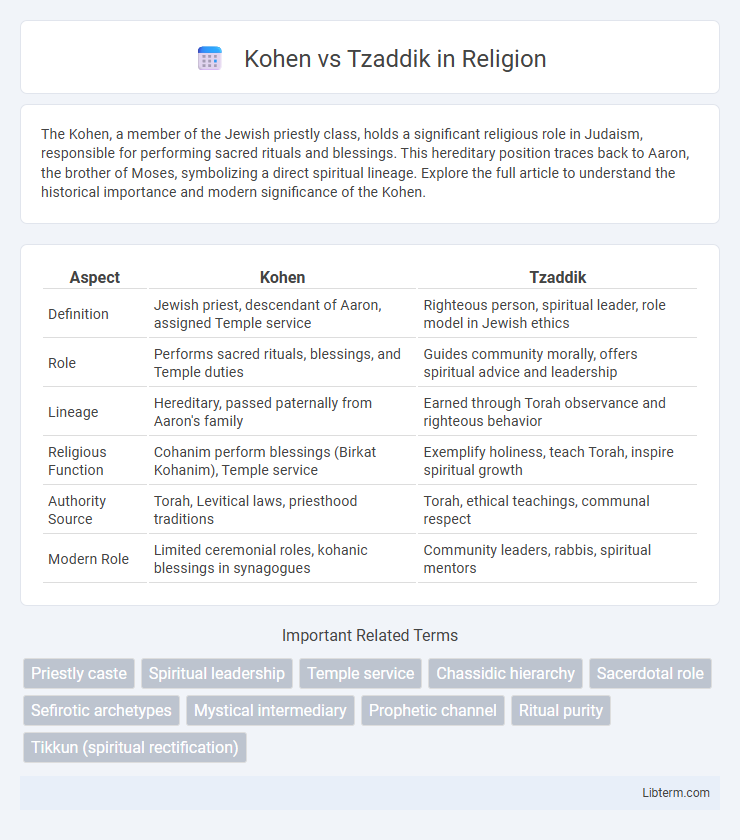The Kohen, a member of the Jewish priestly class, holds a significant religious role in Judaism, responsible for performing sacred rituals and blessings. This hereditary position traces back to Aaron, the brother of Moses, symbolizing a direct spiritual lineage. Explore the full article to understand the historical importance and modern significance of the Kohen.
Table of Comparison
| Aspect | Kohen | Tzaddik |
|---|---|---|
| Definition | Jewish priest, descendant of Aaron, assigned Temple service | Righteous person, spiritual leader, role model in Jewish ethics |
| Role | Performs sacred rituals, blessings, and Temple duties | Guides community morally, offers spiritual advice and leadership |
| Lineage | Hereditary, passed paternally from Aaron's family | Earned through Torah observance and righteous behavior |
| Religious Function | Cohanim perform blessings (Birkat Kohanim), Temple service | Exemplify holiness, teach Torah, inspire spiritual growth |
| Authority Source | Torah, Levitical laws, priesthood traditions | Torah, ethical teachings, communal respect |
| Modern Role | Limited ceremonial roles, kohanic blessings in synagogues | Community leaders, rabbis, spiritual mentors |
Introduction: Understanding Kohen and Tzaddik
A Kohen is a member of the ancient Jewish priestly class, traditionally descending directly from Aaron, tasked with performing sacred rituals and maintaining temple services. A Tzaddik is a righteous individual recognized for exceptional piety, moral integrity, and spiritual leadership within the Jewish community. Understanding the distinct roles and attributes of Kohen and Tzaddik highlights the difference between hereditary religious duties and earned spiritual status.
Historical Origins of the Kohen and Tzaddik
The historical origins of the Kohen trace back to Aaron, the brother of Moses, appointed as the first High Priest in ancient Israel, establishing a hereditary priestly class responsible for temple rituals and sacrifices. The concept of the Tzaddik, however, emerges later in Jewish mysticism and Hasidic traditions, representing a righteous individual who serves as a spiritual leader and guide without hereditary status. Unlike the Kohen's lineage-based role in religious rites, the Tzaddik's authority is derived from personal piety and moral excellence, shaping Jewish communal and spiritual life through exemplary behavior and mystical influence.
Roles and Responsibilities: Kohen vs Tzaddik
Kohen, traditionally a priestly figure in Judaism, holds specific religious roles including performing temple rituals, offering sacrifices, and blessing the congregation during services, responsibilities rooted in ancestral lineage from Aaron. In contrast, a Tzaddik is a righteous individual recognized for spiritual leadership, moral guidance, and interceding on behalf of the community through prayer and righteous deeds, often serving as a mentor and source of inspiration. While Kohanim have formalized duties tied to ritual purity and temple service, Tzaddikim embody ethical excellence and piety, focusing on personal holiness and communal elevation.
Spiritual Authority: Comparing Leadership
Kohen and Tzaddik represent distinct forms of spiritual authority within Jewish tradition, where Kohanim serve as hereditary priests performing Temple rituals and maintaining ritual purity, while Tzaddikim are revered righteous individuals known for personal piety and mystical guidance. The Kohen's leadership is institutional and ritual-based, rooted in divine commandment and lineage, contrasting with the Tzaddik's charismatic influence grounded in ethical excellence and spiritual mentoring. Both roles shape community leadership by embodying different dimensions of holiness--ritual sanctity for Kohanim and moral perfection for Tzaddikim.
Ritual Purity and Sacred Duties
Kohenim hold a unique status in Jewish tradition, tasked with specific sacred duties including performing Temple rituals that require strict adherence to ritual purity laws, such as avoiding contact with the dead to maintain ceremonial cleanliness. In contrast, Tzaddikim, regarded as righteous individuals, embody spiritual purity through ethical conduct and communal leadership rather than formal ritual roles. The Kohen's distinct obligations in maintaining sanctity during Temple service underscore their role in preserving holiness, while Tzaddikim influence ritual purity more symbolically through moral integrity and guidance.
The Tzaddik in Hasidic Thought
The Tzaddik in Hasidic thought embodies the spiritual leader who mediates divine blessings and serves as a conduit between God and the community, contrasting with the Kohen's primarily ritual and priestly role in Judaism. Emphasizing the Tzaddik's mystical connection, Hasidism views him as a source of spiritual elevation and personal transformation through prayer, wisdom, and holiness. This dynamic elevates the Tzaddik beyond lineage-based authority, highlighting charismatic spirituality and the power of righteous leadership for communal redemption.
Lineage vs. Merit: Paths to Holiness
Kohen status is determined by direct lineage from Aaron, emphasizing hereditary sanctity and ritual roles within the Jewish priesthood, while Tzaddik status is earned through personal merit, righteousness, and spiritual achievements. The Kohen's holiness is inherited and linked to specific commandments, whereas the Tzaddik attains holiness through ethical conduct and divine connection. This contrast highlights two distinct paths to holiness: one through ancestral descent and ritual purity, and the other through individual moral excellence and spiritual growth.
Community Impact of Kohenim and Tzaddikim
Kohenim hold a vital communal role by performing priestly rituals, including blessings and Temple service, which reinforce Jewish identity and spiritual continuity. Tzaddikim influence their communities through exemplary piety, guidance, and acts of charity, fostering moral elevation and social cohesion. Both Kohenim and Tzaddikim cultivate community bonds by embodying religious ideals and encouraging communal responsibility.
Modern Relevance and Interpretations
The distinction between Kohen and Tzaddik remains relevant in modern Jewish thought, emphasizing priestly lineage versus righteous behavior. Contemporary interpretations highlight the Kohen's role in ritual purity and communal leadership, while the Tzaddik embodies ethical excellence and spiritual guidance. This dual model informs current discussions on religious authority and personal spirituality within diverse Jewish communities.
Conclusion: Bridging Tradition and Spirituality
Kohen and Tzaddik represent distinct yet complementary spiritual roles within Jewish tradition, with Kohen serving priestly functions rooted in sacred lineage and Tzaddik embodying righteous leadership through personal piety. Bridging tradition and spirituality, their combined influence fosters communal cohesion and ethical guidance essential to Jewish life. Emphasizing both hereditary duty and moral exemplarity enriches the spiritual fabric, creating a holistic approach to faith and practice.
Kohen Infographic

 libterm.com
libterm.com